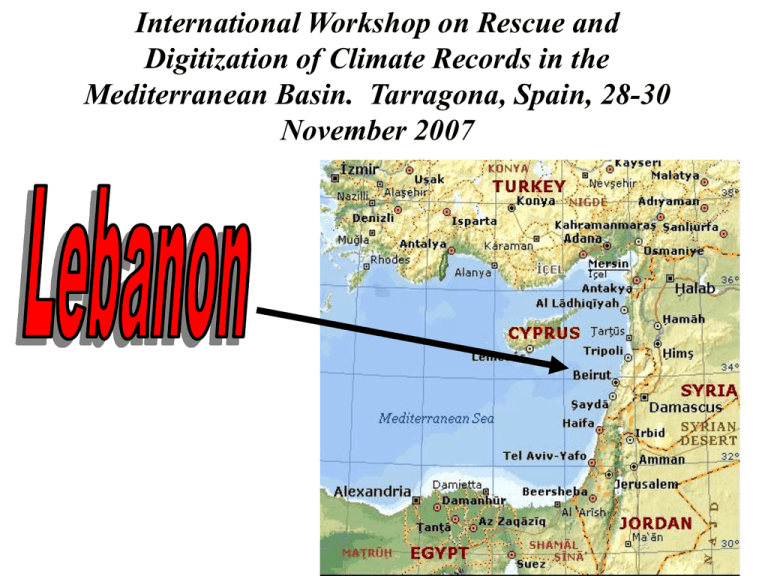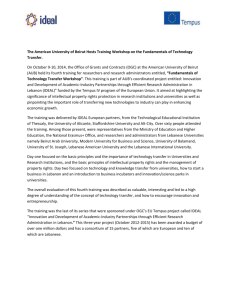Lebanon
advertisement

International Workshop on Rescue and Digitization of Climate Records in the Mediterranean Basin. Tarragona, Spain, 28-30 November 2007 Located on the Eastern Coast of the Mediterra-nean Sea Basin. Lat. 33:10 – 34:40 N Log 35:15 – 36:10 E Surface 10.452 Square Kilometers ( 2/5 of land mountain, mean height 550 m, covered by snow from 900 m, till 3086 m. Rain fall amount: 800 mm on the coastal plain, 900 – 1650 mm on mountains, 225–650 mm on interior plain, Bekaa) Capital : Beirut. Lebanese Meteorological Department Edited by: Dr. Riad Assolh Al KHODARI Chef de la Climatologie Générale Ladies and Gentlemen, In this brief approach, we will try to give you an idea about the Meteorological Department in Lebanon. Measurement of some Meteorological elements in Lebanon are old, as second half of the 19th century, profound by Professors of American University in Beirut, as well as University of Saint Joseph (French University). The 4th of July 1921, is be considered an Official Date of Birth of the Meteorological Department in Lebanon, with the need of Meteorological Forecast, and the establishment of a special center for this purpose. Later, 6 Synoptic Meteorological Stations, Radiosonde Station, Wind Radar, were mounted. Consequently, 187 Meteorological Stations were distributed in the different Lebanese regions. Our progress with study although till 1975, with an unhappy civil war, overwhelmed in Lebanon. It destroyed most of stations and equipment, of NMS. After the war, Meteorological Department asked for help from METEO France, and WMO, in order to reconstruct the National Network. Project was started on August 1994, by the installation of 2 complete AWOS (Milos 500-Fabricant Vaisala-Findland) for Beirut International Airport, and for Tripoli_IPC station (Coastal station at the North of Lebanon). After, the Lebanese -French financial Protocol started on summer 1997 included automatic weather stations, as the following: a) For Surface observations: 7 Complete Synoptic Stations - 3 Agro meteorological Stations - 9 Climatolological Stations connected to METEO Centre at Beirut Airport - 16 Climatological Stations not connected (using PCMCIA card). 7 Climatological Stations prevue to install during few months. b) For Maritime Observations: 3 Buoys installed along Lebanese Coast. c) Upper Air observation: 1 Radiosonde Station at Beirut. d) Weather Radar, to detect Thunder Storms and Probability of Rainfall. 2- Climatological Service in Lebanon, its tasks: Measure and Prepare Statistical Means of different weather parameters: Temperature, Relative Humidity, Evaporation, Precipitations, Wind, Solar Radiation, Air Quality and Environmental parameters ( CO, COз, CHч, NOX, Oз ), Aerosols, and Sea Swell … Using NMS network, dispersed all around Lebanon. Climatological data coming from NMS network form an essential data base, beneficiating to more studies, aimed act providing answers to the anomaly weather extremes, in order to decrease its negative impact on the life in this region, and on the natural resources, especially : Water and Power ! Beneficiaries from our NMS: Public - Government Business: Agriculture - Building and construction Insurance - Legal - Retail and manufacturing - Consulting - Environment - Media -Telecommunications – Energy Water -Transport (Aviation, Marine, Road and rail ). Lebanese weather stations report a mixture of hourly observations of the weather (synoptic observations, collected in real time), and daily summaries of the weather (climate observations, from 16 climate stations come in as collectives at the end of the month). All Climate Stations record hourly and daily maximum and minimum air temperature, relative humidity, rainfall amount, Wind measurement, direction and speed, Insolation time by minutes, Global Radiation amount. 3- History of Data saving and Management Earliest record: By the first of February 1931, daily data for Beirut Airport station. By the first of January 1947: hourly data for Rayak Military Airport station (altitude 920 m), for El-Arz- Les-Cèdres station (altitude 1925 m), and Merdjayoun station (altitude 765m ). • Stage 1: from 1931 till 1994, Manual (Manual data statistic and reports). Observation, Recording instruments, Monthly return reports. Inspected (Visual inspection, Comparison with charts, Statistics), controlled (Check up for all data validity “element limits”, relation ships”, “rate of change, nearby station”), processed, summaries publications, Archived. Till 1994, hard copies and files (on papers and by microfilm) were used for saving and keeping all our climate data in Lebanese Climatolological Section. * Stage 2: from 1994, Digital Data - Minicomputer, - Daily and Monthly statistics only for principal synoptic stations. - Monthly backup. * Stage 3: from 1995 – till 2002, Clicom Programme The beginning of digitize climate data occurred on 1995, by using a special computer to enter all data imported from NMS Network, and saving them. After, Computerize data statistic and reports started with “Clicom” system. Clicom based on MS DOS, with small PC Computer, was installed, and started to enter all climate data registered on papers and files. But, by the end of February 2002, Clicom Programme was stopped, because of many difficulties such as: * Problems coming from non homogenization on working between Clicom equipment and Observations Automatic Stations Network. * Working under Dos Operating System, couldn’t process long climate data base series, especially minute and hourly data. And it was hard to extract reports. * Problems on working in Network. * Arabic language is not supported. * Exported data was not standard to be transferred to another system. * Problems with maintenance, backup, restore and merged data…. * Stage 4, from February 2002: Preparing and developing a locally made Programme (in our NMS, named: Done). Recently, this Programme has been designed as a replacement for the Clicom Programme, only for the moment in order to save and exploit climate data, registered in NMS Network. Until we succeed in obtaining the CliSys, with the funding of WMO. By the locally made Programme, Done, we can perform a wide variety of tasks: a) Data Entry from old papers and files. b) Data Entry from current Observations. c) Importing data from different format. d) Validation and Quality control - semi automatically. e) Archiving & Analyzing climate data, Digitizing Precipitation amount. f) Rescue climate data: 1- Hourly Backup (All Database), 2- Daily Backup (increment data), 3- Monthly Backup (All Database), 4 - Annual Backup (All Database & Application), • Update Station Data after the full network and quality control has been carried out. This usually takes around one to three months. * System Reports Facilities: Generate different kinds of reports, directly in printable form or Excel worksheets. It can retrieve and calculate any data from the database without changing in the original database. * Locally made Programme, Done, can store and Rescue all Climatological Data: Daily data, Hourly data, Monthly data, Upper air data, maritime data (from buoys), and environmental data (Station studying air quality). Climate averages - Long-term averages World Meteorological Organization (WMO) requires the calculation of averages for consecutive periods of 30 years, with the latest covering the 1961-1990 period. However, Lebanese Climatological Service updates their averages at the completion of each decade. These averages help us to describe our climate, used as a base to which current conditions can be compared, and used in our studies on climate change impact in Lebanon and the East Mediterranean Region. Other helpful answers: Definitively, all principal parameters (such as temperature, Relative Humidity, Rainfall amount, wind direction and speed, atmospheric pressure, sun shine and global radiation amount), are digitized, not for all stations, but only for principal stations, preferable and demanded by users, and for our study needs. Length of records: In parallel to the automatic weather stations data registered automatically (records were started by the year 1994, for Beirut Airport and Tripoli_IPC stations, and by the year 1997, for all stations installed by the Lebanese – French Protocol): We digitized the important parameters (such as temperature and rainfall), for the principal manual stations: two coastal stations, from the year 1932, one station on high mountain, from the year 1947, and one station at the interior region, from the year 1943). Resolution of the records are: Hourly, daily, and monthly, in most stations, plus records of 5min, 10min and 30 minutes for Rainfall amount, and records of 30 minutes for maritime data. Problem of time series gaps: The big problem comes by the civil war in Lebanon, (1975 and 1990), which destroyed the majority of Climatological stations. And the obligatory change of stations sites for many reasons. A lot of data registered on papers and files were disappearing, from our NMS offices, our national archive. We placed a Program, to fined lost Climate Data kept outside National Météo Offices: American University in Beirut, University saint Joseph, National Statistics Bureau, and other archives, in which Climate Data are preserved (on paper form, publications or microfilm), in order to create completeness and continuity of Climate Data, to be available for end users, in the period of six to nine months. By the end of this brief approach, we bring to your kind attention our Needs from this Workshop: how to benefit of the MED-DARE programs, applications, practical studies of meteorological scientists, experiences of developed Meteo Services, like those in France, Spain and Germany, to resolve the difficulties and problems for : fostering DARE initiatives at the national scale, developing national long-term climate records, transferring data from paper form to microfiches / microfilms, digitalization issues. Which facilitate the extraction of mid range and long range prediction, concerning the Climate Variability and change. Thank you for your kind attention ________________________ Dr. Riad Assolh Al KHODARI METEO - LEBANON Tel: 00961 3 930 765 00961 1 362 367 Fax: 00961 1 628 187 E.Mail: dr.khodari@hotmail.com






